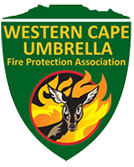legislation
National Veld and Forest Fire Act, No 101 of 1998
The purpose of this Act is to:
- Prevent and combat veld, forest and mountain fires throughout the Republic;
- It makes provision for compliance with environmental requirements as well as for the management of risk to life and property;
- It set out minimum enforceable standards which must be achieved by all landowners (both public and private) e.g. firebreaks & preparedness;
- It provides for a variety of institutions, methods and practices to achieve its purpose.(e.g. FPAs).
The National Veld and Forest Fire Act places specific responsibilities on landowners from whose property the possibility exists that a fire may start and spread:
Firebreaks
Chapter 4 of the NVFFA places a duty on landowners to prepare and maintain firebreaks and set out the following requirements:
- It is wide enough and long enough to have a reasonable chance of preventing a veldfire from spreading to or from neighboring land;
- It does not cause soil erosion; and
- It is reasonably free of inflammable material capable of carrying a veldfire across it.
The Act further states that owners of adjoining land may agree to re-position a common firebreak away from the boundary. This can be achieved through a mutual firebreak agreement. The Ministers may exempt any owner or group of owners from the duty to prepare and maintain a firebreak or firebreaks for good reason.
For assistance and guidance regarding the establishment and maintenance of firebreaks, please contact the designated Ward Manager.
Fire Fighting
Chapter 5 of the NVFFA places a duty on all landowners to acquire equipment and have available personnel to fight fires. The act also makes provision for a landowner to appoint an agent to do all that he or she is required to do in terms of Chapter 5.
The CPFPA has compiled a list of minimum requirements in terms of firefighting equipment:
Equipment can be purchased from Safe Quip (CPFPA members are eligible for a discount):
Mark Moller
Hardo Oosthuizen
Basic Wildfire Suppression training can be done through Enviro Wildfire Consultancy (Pty) Ltd or alternatively Enviro Wildfire Services, please download training brochures for more information:
Contact:
Rob Erasmus – Enviro Wildfire Consultancy
Petra Kranenberg – Enviro Wildfire Services
National Environmental Management: Biodiversity Act 10 of 2004
The purpose of this Act is to:
- Provide for the management and conservation of South Africa's biodiversity within the framework of the National Environmental Management Act, 1998;
- The protection of species and ecosystems that warrant national protection;
- The sustainable use of indigenous biological resources;
- The fair and equitable sharing of benefits arising from bioprospecting involving indigenous biological resources;
- The establishment and functions of a South African National Biodiversity Institute; and
- For matters connected therewith.
Invasive alien species are controlled by the National Environmental Management: Biodiversity Act, NEMBA, and places the responsibility and legal liability on landowners to control invasive alien vegetation on their properties. NEMBA has further divided invasive species into four categories;
Category 1a:
Invasive species which must be combatted and eradicated. Any form of trade or planting is strictly prohibited.
Category 1b:
Invasive species which must be controlled and wherever possible, removed and destroyed. Any form or trade or planting is strictly prohibited.
Category 2:
Invasive species, or species deemed to be potentially invasive, in which a permit is required to carry out a restricted activity. Category 2 species include commercially important species such as pine, wattle and gum trees.
Category 3:
Invasive species which may remain in prescribed areas or provinces. Further planting, propagation or trade, is however prohibited.
Conservation of Agricultural Resources Act 43 of 1983
The purpose of this Act is to:
- Provide for control over the utilization of the natural agricultural resources of the Republic in order to promote the conservation of the soil, the water sources and the vegetation and the combating of weeds and invader plants; and
- For matters connected therewith.
As per NEMBA, Conservation of Agricultural Resources Act, CARA, also regulates and control invasive plant species, however, focuses more on invasive plant species within the agricultural sector. All plant species listed under CARA are included under NEMBA regulations.
Community Fire Safety By-Law, 2007
The purpose of this By-Law is to:
- Promote the achievement of a fire-safe environment for the benefit of all persons within the area of jurisdiction of the Municipality;
- Repeal all existing relevant by-laws of the Municipality;
- Provide for procedures, methods and practices to regulate fire safety within the area of jurisdiction of the Municipality.
Chapter 7 of the Community Fire Safety By-Law deals with fire hazards;
34. Combustible material
- (1) A person may not store, transport, use or display or cause or permit to be stored, transported, used or displayed, whether inside or outside the premises, any combustible material or a flammable substance in quantities or in a position or in a manner likely to cause or create a fire hazard or other threatening danger.
- (2) The owner or person in charge of the premises may not permit vegetation to grow or accumulate thereon, or other combustible material to accumulate thereon, in a manner likely to cause a fire hazard or other threatening danger.
This by-law is enforced by City of Cape Town Fire and Rescue Services, specifically the Fire and Life Safety Department.







